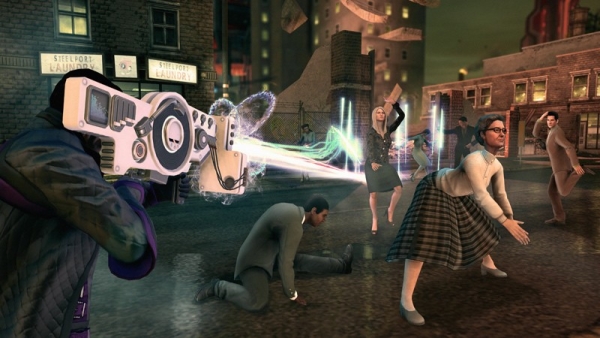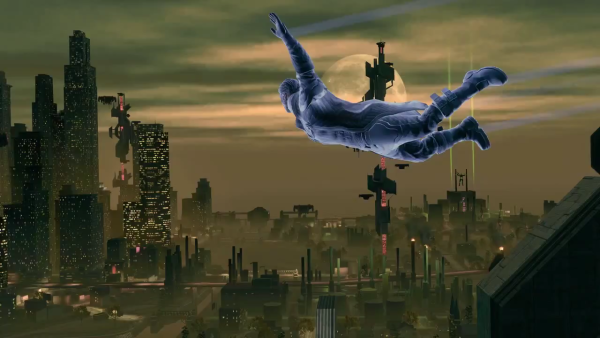Typically when an open-world sandbox game has both a story and squishy pixel people to potentially torment, it never comes together as well as it should. “Ludo-narrative dissonance” is what all the cool kids are calling it nowadays, and essentially what this means is that a character’s personality and motivations, as outlined through cutscenes or scripted dialogue, is at odds at what that character can, and probably will be doing outside the story in the player-controlled portion of the game. Grand Theft Auto IV’s Nico Bellic is supposed to be a nice guy right? Sure, he’s a little hungry for revenge. OK, yes, his background can justify a bit of brutality. But when I wrestled a man out of a car, threw him to the concrete, knocked him out with a skull-splitting punch, drove his car along the sidewalk all the way to Star Junction, and went on a rocket launcher spree… well then it’s difficult to reconcile gameplay Nico with cutscene Nico.
The only way, in my mind, to have both a story and a game world where the player is free to steal, murder, and terrorize at will, is to have the player character be a sociopath. Or as Saints Row IV insists on terming it: a “puckish rogue.”
 At its core, Saints Row IV works by unifying player will, player freedom, and authored narrative. There is no dissonance between what the Third Street Saints’ boss would do and what I will do when presented with a consequence-free world. The Saints’ Boss – for me, obese, suited in purple, and with a thick cockney accent – wants to punch people in the crotch and drift his gold-rimmed golf buggy into a crowd of pedestrians, guffawing as they ragdoll spectacularly into the sunset. Not because he’s a necessarily a bad guy, but because his world is a playground filed with sandcastles who happen to be shaped like people, and because one of most fun things to do with sandcastles is kick them over.
At its core, Saints Row IV works by unifying player will, player freedom, and authored narrative. There is no dissonance between what the Third Street Saints’ boss would do and what I will do when presented with a consequence-free world. The Saints’ Boss – for me, obese, suited in purple, and with a thick cockney accent – wants to punch people in the crotch and drift his gold-rimmed golf buggy into a crowd of pedestrians, guffawing as they ragdoll spectacularly into the sunset. Not because he’s a necessarily a bad guy, but because his world is a playground filed with sandcastles who happen to be shaped like people, and because one of most fun things to do with sandcastles is kick them over.
The game works by being as outlandish and silly as possible, for the alternative would be a grim thing indeed. Saints Row: The Third cemented the series as much more than a second-rate Grand Theft Auto by embracing the absurd. In Saints Row IV, the Boss is President of the United States, and we’re locked into a simulation to fight aliens with superpowers. There’s context to that, but most of it is a conceit to have the player re-tread the streets of Steelport, here painted over with a retro-futuristic lick of paint, and with a handful of alien towers sprouted into the sky. It’s the same city, on the same game engine, but it’s far from the same experience. Saints Row IV is the most unique game in the series, and it’s the purest example of Volition’s philosophy in making these games: indulge the audience.
It indulges first with the customization. Pick a gender and then subvert it if you like. Clothe a man in a dress. Give a woman the voice of Nolan North. Max out a guy’s “sex appeal” slider to increase the size of his package. Play a character as straight-faced or as visually dissident as you like, then make that character the leader of the free world. Nobody will bat an eyelid.
Next, you’ll be given super powers to play around with while you’re in simulated Steelport. Super speed to tear down roads, knocking cars and pedestrians aside in your slipstream. Super jump to bound up buildings before gliding back down to earth. Freeze blast to hold the alien Zin in place while you line up your shots to shatter them. Be a superhuman, and then use those powers to throw squirming citizens into oncoming traffic. Don’t do it for a reason, do it simply because you can. Customize your shotgun plaid purple just so it matches your dress. Earn a gun that summons dubstep from the heavens, makes vehicles bounce on their suspension, and makes everyone around you dance until they die.
There is a story that contrives to find as many ways as possible for you to defend a location while fighting off waves of aliens, some with super powers like your own, some as hulking mini-boss monstrosities. Mostly, though, the primary missions are an excuse for even more indulgence in the name of fan service, both for fans of the franchise and fans of games in general. I won’t go into specifics, because most of the joy comes from the surprise, but it’s sincere and amusing, and incentivizes a set of story missions that are otherwise only there to have you shoot more aliens, or introduce the sandbox’s set of side missions.
All told, the best part of Saints Row IV is that it gives you the tools to enjoy play in and of itself. The super powers, along with the reams of unique weaponry, the extent of customization, and a radio that’s accessible even outside of vehicles combine to make simply chilling around the city the best part of the game. Bounce around buildings looking for the collectibles necessary for upgrading your powers. Drive in the oncoming lane for “respect” so you can unlock that alluringly destructive power upgrade. Float around the night sky while listening to electronica.
Why? Not particularly because there’s a story in Saints Row IV, but because you can, and because these are all fun and unusual things to do. Because this is a ridiculous power fantasy. Because this is indulgence in its purest form. Because Saints Row IV is a toy – a wonderful, stupid, sincerely amusing toy.



















